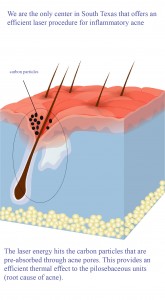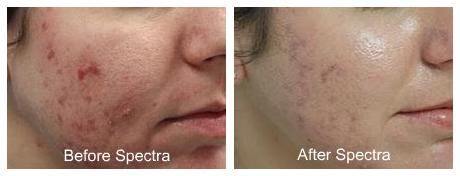Acne Treatment for San Antonio & Boerne Residents
Our top ranking Dermatologists at the Institute’s Acne Clinic have successfully treated thousands of patients with Acne
The Acne Clinic offers a comprehensive package for treating Acne of various ethnic origins
Treatment options include: topical face wash and creams, oral treatments, state-of-the art lasers, and dermabrasion
Our Acne specialists not only treat your Acne but also offer the latest knowledge on how to prevent future flare-ups
Proper choice of make-up, diet, and how to care of oily or dry skin will be discussed during your consultation
TXID Acne Clinic in San Antonio, is a top ranking Acne Center in South Texas dedicated to the treatment of various forms of Acne. Whether you are facing new onset Acne or dealing with poorly controlled Acne with scarring, our renowned dermatologists can help. Click here to hear more about our patients’ own experience.
At San Antonio Acne Clinic, our dermatologists have successfully treated Acne of various ethnic origins, including skin of color. Our well known dermatologists, with years of experience in teaching and research, have received special training on how to treat severe forms of Acne. Dermatologists at our Acne Clinic treat hundreds of patients with various forms of Acne on a monthly basis. Most Acne patients notice significant improvement after a few weeks of their initial visit. Dr. Ghohestani, our renowned dermatologist, offers a comprehensive treatment package for Acne including face wash, medicated lotions, oral anti-inflammatory agents, microdermabrasion, AFT light treatment and lasers, and finally Isotretinoin (Claravis, Accutane). State-of-the art lasers are designed for treatment of Acne and Acne Scarring. Sometimes, he may request additional labs to determine the possible effect(s) of sex hormones or other factors in the development of Acne.
What is Acne?
Acne Vulgaris is a common disease of the pilosebaceous unit or sebaceous follicle. Acne is most often characterized by inflammatory and/or noninflammatory lesions including papules, pustules, nodules, cyst and comedones (black heads and white heads). Acne is often seen on areas of the body where there are numerous sebaceous glands including the face, upper chest and upper back. Chin and peri-oral area are usually affected in females.
What Causes Acne?
Acne blemishes do not happen overnight. It is a process that starts two to three weeks before the lesion is actually visible on the skin’s surface. Acne begins in the pilosebaceous unit, which is the skin structure consisting of the hair follicle and its associated sebaceous gland. During puberty, the body begins producing sex hormones called Androgens. These hormones send a signal to the the sebaceous gland to initiate the secretion process of sebum. Sebum is a natural oil that aids in maintaining the skin’s moisture and elasticity. When there is an increased amount of hormone stimulation released, there is extra sebum production within the hair follicle. Sebum is rich in essential lipids, but it also attracts acne-causing bacteria called Propionibacterium acne or (P. Acne). Recent studies show that insulin may also increase sebum production. Hence, a high glycemic diet may worsen acne. As our skin continually rebuilds itself, new skin cells are pushed to the surface as the old skin cells die and are sloughed off. When this normal process of skin rejuvenation does not occur, it results in excessive accumulation of dead skin cells and oils that will plug the pore. The anaerobic environment of the hair follicle that is plugged with a comedo provides a thriving breeding ground for the bacteria (P. Acne). The visible acne lesions seen on the surface of the skin are a result of excess oil and dead skin cells that have clogged the pore of the hair follicle and caused it to rupture. Underneath the plug or “comedo,” the bacteria continues to grow and the supply of sebum increases which results in increased swelling, inflammation and eventual rupture of the hair follicle. Your body responds to the inflammation by sending white blood cells to fight. This process results in the formation of an acne lesion, more commonly called a pimple. Pimples eventually open up or rupture and cause a severe inflammatory reaction. Sometimes, cysts develop with subsequent scar formation.
Treatment Options For Acne
Acne treatments will vary from person to person and depend on the severity of the disease: Mild, Moderate, or Severe. The first step to finding the best treatment is to set up a consultation with a dermatologist with special expertise in acne treatment. During your initial appointment, Dr. Ghohestani, our renowned dermatologist, will examine your skin, take a thorough medical history, discuss your aesthetic goals, and finally suggest a specific course of treatment tailored to your needs. You could be given a combination of over-the-counter and prescription creams, face washes, and oral anti-inflammatory treatments. Doxycycline and Minocycline are widely used to reduce the amount of inflammation. There are various formulations such as Monodox or Doryx that offers a delayed release of Doxycycline with potentially less side effects. You may elect to include procedures such as microdermabrasion, IPL, AFT, Spectra Laser with or without carbon as part of your acne regimen. Usually, a combination of laser and microderm clears up Acne quickly, especially when an AFT or laser spectra is combined with the topical face washes and creams. I-Clear (TM) is of the most effective methods of treating Acne scarring. I-clear is a combination of 3 cutting edge technologies including Sodium bicarb Microdermabrasion, Spectra laser and fractional Co2 laser. Recently, Botox has been introduced as a novel method for treatment of Acne Vulgaris (common Acne). This method has been particularly useful for severe forms of Acne on the forehead. Dr. Ghohestani’s team is one of the few teams in country that offers this unique approach for the treatment of Acne.

Laser Treatments
Laser Acne treatment by CarbonWe, at Texas Institute of Dermatology – San Antonio Acne Clinic, offer several laser treatments for Acne and Acne Scarring. The laser significantly reduces redness and inflammation by targeting pilosebaceous units (the root cause of acne). Acne scarring can be treated with a fractional Co2 laser in combination with other technologies as part of I-Clear (TM) developed by our research team at Texas institute of Dermatology.
Fractional Co2 Laser For Acne Scarring
Fractional Co2 is one the most efficient ways of treating Acne Scarring. For more information, click here.
Laser Spectra Peel
For laser spectra peel, we first apply a thin layer of carbon particles, then allow 15 minutes for the their absorption through skin pores. The laser targets the carbon particles and provides an effective thermal effect to the deep parts of skin where the pilosebaceous units reside. We usually recommend a combination of Microdermabrasion and laser for treatment of Acne. Microdermabrasion removes the superficial layer of skin, thereby increasing the laser’s efficiency. It also removes the comedons. Acne scarring can be treated with our state-of-the art fractional C02 laser. To watching a video on laser spectra, please click here.
Acne Related Pigmentation Changes

Pigmentation changes are more common in acne prone skin than scarring, and they are usually easier to treat. Color changes in the skin can be resolved but may take years to completely disappear. These pigmentation changes can be broken down into three basic categories: Erythema, Hyperpigmentation, and Hypopigmentation.
Erythema: pink and purple patches at the site of acne lesions
Hyperpigmentation: Hyperpigmentation is an excess amount of pigmentation in the tissue of the skin. Pigmented lesions are spots on the skin where there is a higher concentration of melanin. It is generally a grey/brown/black discoloration at the site of the acne lesion. Hyperpigmentation is not only caused by acne but may also be a result of hormonal changes (such as Melasma), sun damage, injuries, your skin type, or certain medications.
Hypopigmentation: white marks at the site of a healed acne lesion. Post inflammatory hypopigmentation is very common in those with darker skin tones or in those who tan easily and can significantly worsen the appearance of acne.
Treatment For Pigmentation Changes
Proper treatment of hyperpigmentation is largely based on its cause, your aesthetic goals and your skin type. The first step is to set up a consultation with Dr. Ghohestani to determine the cause of the pigmentation changes. He will examine your skin, take a thorough medical history, discuss your aesthetic goals and then suggest a course of treatment individualized to your skin type. Treatments for hyperpigmentation include: Prescription Topicals, Microdermabrasion, AFT Laser Treatments, Laser Skin Resurfacing, and Chemical Peels.
Prescription Topicals: Prescription creams such as Retin-A (topical retinoid) , 4% Hydroquinone (bleaching agent), or a combination of both plus a cortisone cream may be prescribed. These treatments can be quite effective when used properly.
Microdermabrasion: Another popular procedure for the treatment of hyperpigmentation is microdermabrasion.This method uses sodium bicarb crystals that are propelled at the skin and immediately sucked up into a small vacume. It is a very popular, painless procedure with no recovery time. However, to effectively treat acne discoloration, several treatments may be required.
AFT Laser Treatments: Advanced Fluorescent Technology (AFT) represents one of the latest advances in intense pulsed light(IPL). Previous IPL treatments had to work hard to eliminate harmful, short-wavelenght light in order to protect patients. The AFT is able to convert these harmful rays into usable light by means of a special filtering system. This improves the laser’s safety, efficiency, and efficacy for patients.
Laser Skin Resurfacing: Laser skin resurfacing is an ablative procedure, meaning the laser removes the outer layers of the skin. Both the CO2 and the Erb Yag lasers are designed to penetrate through the epidermis and superficial dermis and are highly effective in the treatment of acne scarring. Like dermabrasion, laser resurfacing is ablative. Ablative techniques are more effective, but they require more recovery time.
Chemical Peels: Chemical peels (or chemical resurfacing) is used to improve the appearance of the skin, including acne scars. Specific chemicals are used, such as glycolic acid, trichloroacetic acid (TCA), and salicylic acid to produce differing degrees of controlled injury to the skin. The natural healing process of the body then takes over to produce new, healthier looking skin. Medium depth and deep peels produce injury within the dermis and can improve the appearance of atrophic acne scars. The deeper peels are more effective but carry more risks such as infection, scarring, and discoloration, especially for patients with dark skin. Nowadays, chemical peels are being replaced by various laser procedures.
Why Choose The Texas Institute Of Dermatology For Your Acne Treatments?
Our mission is to serve as a leading center for understanding and treating Acne and Rosacea in South Texas through excellence in patient care, research, and education. We want you to feel that you have been treated with the comfort, privacy, safety, and satisfaction that you deserve. This is why all of our procedures are performed or supervised by our renowned dermatologist, Dr. Reza F. Ghohestani. Our Dermatologist’s experience, combined with the latest technology and caring staff, is why the Institute is consistently ranked among the top dermatology centers for Acne treatment in San Antonio and Boerne areas based on satisfaction surveys. We currently serve communities throughout Bexar and Kendall counties, including San Antonio, Boerne, Leon Springs, Fair Oaks Ranch, Canyon Lake City, etc. Many of our patients also come from San Marcos, New Braunfels, Kerrville, Austin, Wimberly, and Corpus Christi.

